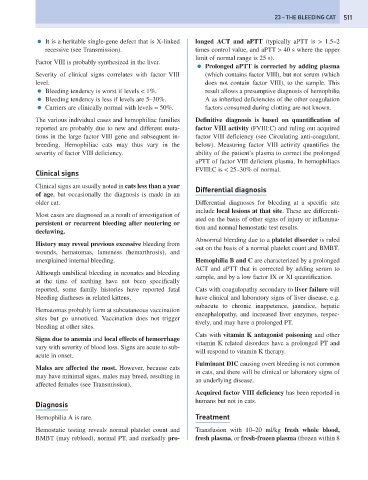Page 519 - Problem-Based Feline Medicine
P. 519
23 – THE BLEEDING CAT 511
● It is a heritable single-gene defect that is X-linked longed ACT and aPTT (typically aPTT is > 1.5–2
recessive (see Transmission). times control value, and aPTT > 40 s where the upper
limit of normal range is 25 s).
Factor VIII is probably synthesized in the liver.
● Prolonged aPTT is corrected by adding plasma
Severity of clinical signs correlates with factor VIII (which contains factor VIII), but not serum (which
level. does not contain factor VIII), to the sample. This
● Bleeding tendency is worst if levels < 1%. result allows a presumptive diagnosis of hemophilia
● Bleeding tendency is less if levels are 5–30%. A as inherited deficiencies of the other coagulation
● Carriers are clinically normal with levels ≈ 50%. factors consumed during clotting are not known.
The various individual cases and hemophiliac families Definitive diagnosis is based on quantification of
reported are probably due to new and different muta- factor VIII activity (FVIII:C) and ruling out acquired
tions in the large factor VIII gene and subsequent in- factor VIII deficiency (see Circulating anti-coagulant,
breeding. Hemophiliac cats may thus vary in the below). Measuring factor VIII activity quantifies the
severity of factor VIII deficiency. ability of the patient’s plasma to correct the prolonged
aPTT of factor VIII deficient plasma. In hemophiliacs
FVIII:C is < 25–30% of normal.
Clinical signs
Clinical signs are usually noted in cats less than a year
Differential diagnosis
of age, but occasionally the diagnosis is made in an
older cat. Differential diagnoses for bleeding at a specific site
include local lesions at that site. These are differenti-
Most cases are diagnosed as a result of investigation of
ated on the basis of other signs of injury or inflamma-
persistent or recurrent bleeding after neutering or
tion and normal hemostatic test results.
declawing.
Abnormal bleeding due to a platelet disorder is ruled
History may reveal previous excessive bleeding from
out on the basis of a normal platelet count and BMBT.
wounds, hematomas, lameness (hemarthrosis), and
unexplained internal bleeding. Hemophilia B and C are characterized by a prolonged
ACT and aPTT that is corrected by adding serum to
Although umbilical bleeding in neonates and bleeding
sample, and by a low factor IX or XI quantification.
at the time of teething have not been specifically
reported, some family histories have reported fatal Cats with coagulopathy secondary to liver failure will
bleeding diatheses in related kittens. have clinical and laboratory signs of liver disease, e.g.
subacute to chronic inappetence, jaundice, hepatic
Hematomas probably form at subcutaneous vaccination
encephalopathy, and increased liver enzymes, respec-
sites but go unnoticed. Vaccination does not trigger
tively, and may have a prolonged PT.
bleeding at other sites.
Cats with vitamin K antagonist poisoning and other
Signs due to anemia and local effects of hemorrhage
vitamin K related disorders have a prolonged PT and
vary with severity of blood loss. Signs are acute to sub-
will respond to vitamin K therapy.
acute in onset.
Fulminant DIC causing overt bleeding is not common
Males are affected the most. However, because cats
in cats, and there will be clinical or laboratory signs of
may have minimal signs, males may breed, resulting in
an underlying disease.
affected females (see Transmission).
Acquired factor VIII deficiency has been reported in
humans but not in cats.
Diagnosis
Hemophilia A is rare. Treatment
Hemostatic testing reveals normal platelet count and Transfusion with 10–20 ml/kg fresh whole blood,
BMBT (may rebleed), normal PT, and markedly pro- fresh plasma, or fresh-frozen plasma (frozen within 8

